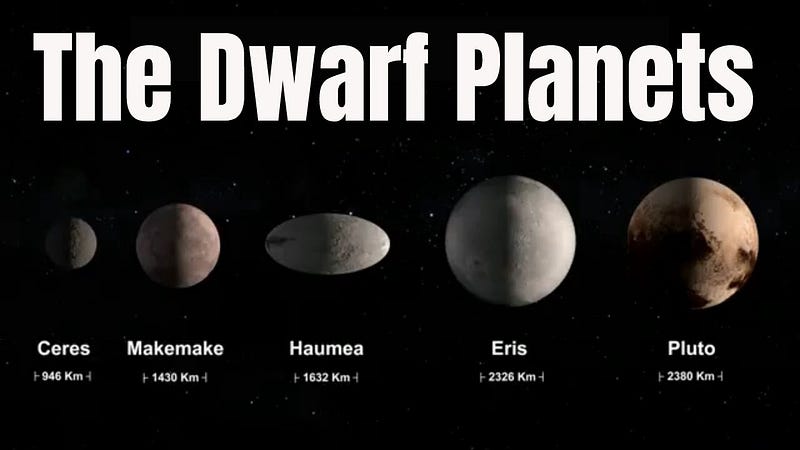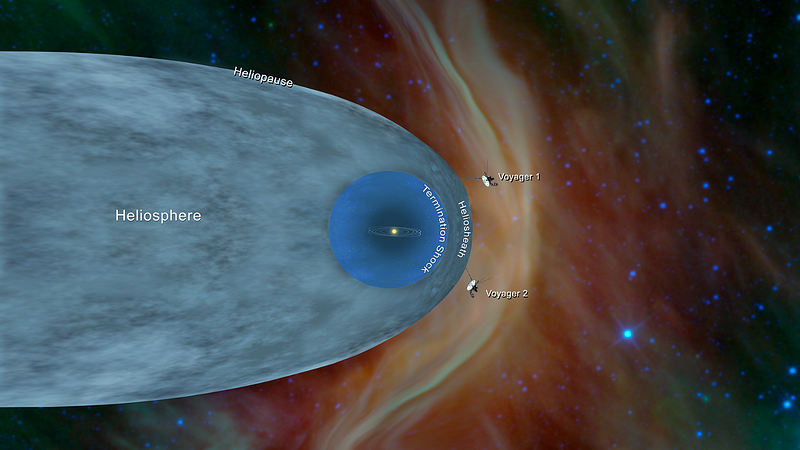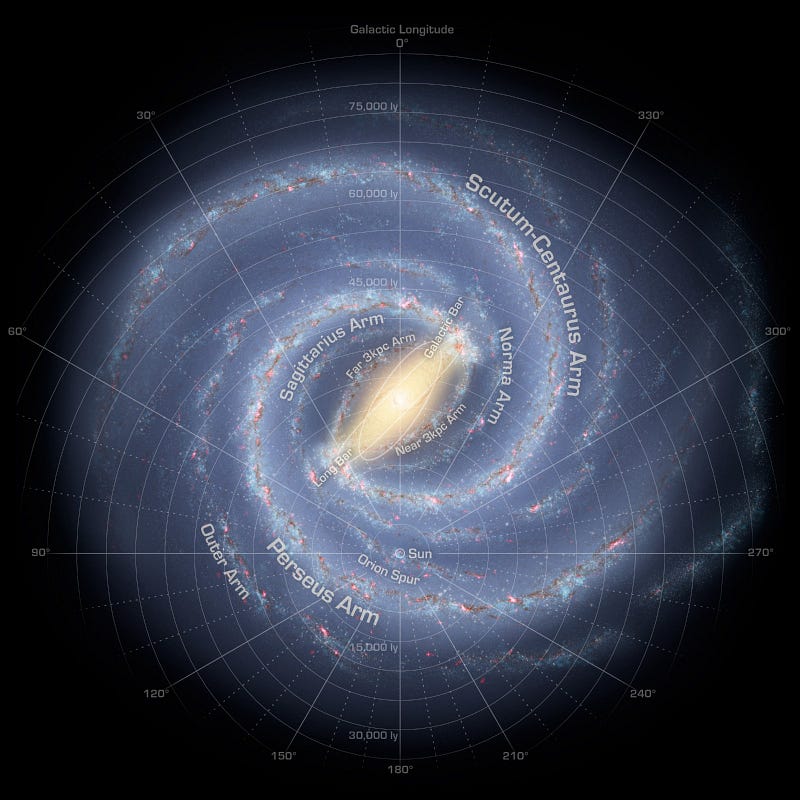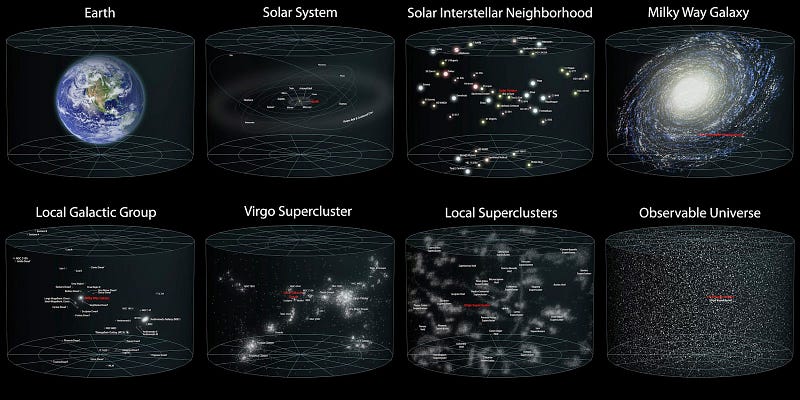Understanding Our Place in the Cosmos: Earth's Cosmic Address
Written on
Chapter 1: Measuring Cosmic Distances
When we gauge distances on Earth, we often refer to inches, feet, yards, or kilometers. However, this approach becomes impractical when discussing the positioning of celestial bodies in relation to our planet. In cosmic terms, we utilize much larger units of measurement. The Astronomical Unit (AU) is the smallest of these, representing the distance from Earth to the Sun, approximately 150 million kilometers (93 million miles) or about 8 light minutes.
For instance, when considering Saturn's distance from Earth, it is more useful to express it in AU rather than kilometers. Saturn, on average, is about 1,427,000,000 kilometers away, which translates to roughly 9.5 AU.
The second method of measuring astronomical distances involves the time it takes for light to traverse those distances. The speed of light, a universal constant, travels at about 299,792,458 meters per second (roughly 186,282 miles per second), marking the ultimate speed limit of the universe. This speed is often represented as c = 3 x 10^8 m/s. Distances within our solar system and beyond are frequently described in light minutes, light years (1 light year = 63,241 AU), and even mega-light years (MLY) and giga-light years (GLY) for immense spans.
For example, light from the Moon takes about 1.3 seconds to arrive at Earth, thus it is 1.3 light-seconds away. Meanwhile, light from the Sun requires 8 minutes to reach us, making it 8 light minutes away. On a grander scale, the Andromeda Galaxy, our nearest galactic neighbor, is located approximately 2.537 MLY away.
The video "What is Our Cosmic Address?" delves into the concepts of cosmic distances and how they relate to our understanding of the universe.
Section 1.1: The Inner and Outer Solar System
Utilizing these measurement units, we can grasp our position in the universe on a broader scale. Humans reside on Earth, which is part of our solar system, orbiting our star, the Sun. This system encompasses seven other planets, dwarf planets, moons, comets, and asteroids. The solar system can be categorized into two sections: the inner and outer solar systems.
The inner solar system consists of the terrestrial planets: Mercury, Venus, Earth, and Mars. The asteroid belt, located between Mars and Jupiter, separates the inner from the outer solar system. This belt is approximately 1.2 AU from Earth and spans about 92 million miles, or just under 1 AU.
Conversely, the outer solar system includes the gas giants: Jupiter, Saturn, Uranus, and Neptune. Neptune is the furthest planet from Earth at about 30 AU or roughly 4 light-hours away. However, it is not the most distant body; beyond Neptune's orbit lie several dwarf planets, which do not meet the criteria for full planetary status.
Subsection 1.1.1: Criteria for Planetary Status
To be classified as a planet, a celestial body must fulfill three criteria:
- It must orbit a star.
- It must possess enough mass for its self-gravity to enable a nearly spherical shape.
- It must have cleared its neighboring orbit of debris.

Source: MooMoo Math and Science
Dwarf planets, such as Pluto, Ceres, Makemake, Haumea, and Eris, do orbit the Sun and are generally spherical, yet they have not cleared their orbits of other debris.
Chapter 2: The Kuiper Belt and Beyond
Dwarf planets inhabit the Kuiper Belt, a ring of icy bodies beyond the outer solar system. This region, also known as the Edgeworth–Kuiper Belt, is expected to contain millions of objects, referred to as Kuiper Belt Objects (KBOs).
The video "What is Our Cosmic Address?" further explores the significance of the Kuiper Belt in understanding our solar system.
The Kuiper Belt extends from about 30 AU, just past Neptune's orbit, to 50 AU from the Sun, making it significantly wider and more massive than the asteroid belt. Both belts are remnants from the early solar system and can offer valuable insights into planetary formation.
The Heliopause and the Oort Cloud
The heliosphere, defined by the influence of solar winds, forms a protective bubble around our solar system, extending up to 123 AU. Beyond this lies the heliopause, the boundary where solar wind pressure is balanced by the interstellar medium.

Source: JPL
Beyond the heliopause is the Oort Cloud, a hypothesized spherical shell marking the outer limits of our solar system. It is estimated to begin between 2,000 and 5,000 AU from the Sun, extending out to as far as 100,000 AU. This region could contain trillions of icy bodies.
The Local Interstellar Cloud
Our solar system is currently traversing the Local Interstellar Cloud (LIC), which is composed of hydrogen and helium and spans approximately 30 light years. This cloud is part of the larger Local Bubble, measuring about 300 light years in diameter.
The Orion Arm
The Local Bubble is situated within the Orion Arm of the Milky Way, a minor spiral arm that is about 3,500 light years wide. Our solar system is located about 26,000 light years from the Galactic Center within this arm.

The Milky Way Galaxy
The Milky Way Galaxy, an intricate structure of gravitationally bound stars, spans about 100,000 light years and contains between 100 to 400 billion stars. While initially thought to consist of four main arms, recent findings have reclassified some of these as minor arms.
The Local Galactic Group
The Milky Way is part of the Local Galactic Group, which contains 30-50 galaxies and spans around 10 million light years. The Andromeda Galaxy is the most notable member, followed by the Milky Way and the Triangulum Galaxy.
The Virgo Supercluster
Our Local Group is located at the edge of the Virgo Supercluster, which spans 110 MLY in diameter.
The Laniakea Supercluster
Recent discoveries revealed that the Virgo Supercluster is a part of the larger Laniakea Supercluster, which encompasses about 100,000 galaxies across 520 million light years.

Source: Wikipedia
In conclusion, our cosmic address could be expressed as:
Humanity
Earth, 3rd Planet Inner Solar System, Orion Arm
Milky Way Galaxy, Virgo Supercluster, Laniakea Supercluster

Source: Wikipedia